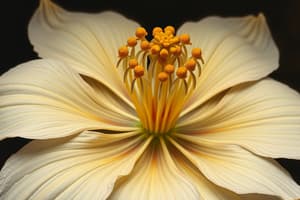Podcast
Questions and Answers
What are the male reproductive organs of a flower called?
What are the male reproductive organs of a flower called?
- Corolla
- Stamens (correct)
- Pistils
- Calyx
Incomplete flowers possess all four whorls of floral parts.
Incomplete flowers possess all four whorls of floral parts.
False (B)
What is the function of the stigma in a flower?
What is the function of the stigma in a flower?
The stigma is the sticky part that receives pollen grains.
A flower with both male and female reproductive parts is classified as a __________ flower.
A flower with both male and female reproductive parts is classified as a __________ flower.
Match the following terms with their definitions:
Match the following terms with their definitions:
Which type of flower can only be divided into identical halves in one plane?
Which type of flower can only be divided into identical halves in one plane?
A dioecious plant has both staminate and pistillate flowers on the same plant.
A dioecious plant has both staminate and pistillate flowers on the same plant.
What is the definition of a perfect flower?
What is the definition of a perfect flower?
In a _____ flower, sepals, petals, and stamens are attached below the ovary, making it superior.
In a _____ flower, sepals, petals, and stamens are attached below the ovary, making it superior.
Match the flower type with its description:
Match the flower type with its description:
Flashcards are hidden until you start studying
Study Notes
Announcements
- Online practical scheduled.
- Quiz on 18 September.
- Submission of drawing books on 19 & 20 September.
- Test 2: 12 September 2024 at 17h00, venues KA & KB, same format as Test 1.
- Scope of Test 2: Chapters 5, 6, and part of 7 (up to flowering).
Flower Structure
- A flower is a modified shoot primarily for reproduction, consisting of four whorls:
- Calyx: Composed of sepals that protect the young flower (green).
- Corolla: Made of petals that attract pollinators (colored).
- Androecium: Consists of stamens (anther and filament) that produce male gametes.
- Gynoecium: Comprises the pistil or carpels (stigma, style, ovary) which bear ovules.
- Tepals occur when sepals and petals look identical or are fused.
Reproductive Organs
- Male sex organs: Stamens (anther produces pollen, filament supports anther).
- Female sex organs: Carpels/pistil (ovary holds ovules; stigma is the pollen receptor; style connects stigma to ovary).
Non-Reproductive Floral Organs
- Sepals: Outer whorl that protects flower buds.
- Petals: Inner whorl that attracts pollinators.
- Tepals: Indistinguishable sepals and petals.
Flower Classification
- Complete flower: All four whorls present, whereas incomplete flowers lack one or more.
- Perfect flower: Contains both male and female parts; imperfect flowers have only one.
- Monoecious species possess both types of flowers on the same plant; dioecious species have them on separate plants.
- Actinomorphic (regular): Radially symmetrical; zygomorphic (irregular): Bilaterally symmetrical.
Coalescence and Adnation
- Coalescence: Joining of members within the same whorl.
- Synsepaly: Joined sepals; aposepaly: free sepals.
- Synpetaly: Joined petals; apopetaly: free petals.
- Adnation: Joining of members from different whorls.
- Hypogynous: Parts below ovary; perigynous: ovary within a hypanthium; epigynous: parts above ovary.
Carpels and Placentation
- Carpels: Modified leaves forming cavities for ovules.
- Locules: Cavities within the ovary (unilocular, bilocular, trilocular).
- Placenta: Area in the ovary where ovules attach, with different placentation patterns:
- Parietal, Marginal, Axile, Free/central, Apical, and Basal placentation.
Inflorescences
- Flowers can be solitary or in clusters on an axis called the rachis.
- Inflorescence types are classified based on flower arrangement and attachment.
Types of Inflorescences
-
Simple monopodial:
- Raceme: Indeterminate growth with pedicels of equal lengths.
- Spike: Unbranched with sessile flowers.
- Catkin: Long and unisexual.
- Spadix: Fleshy spike with separate staminate and pistillate flowers.
- Umbel: Flowers from the same point on the peduncle.
- Corymb: Flat-topped; oldest flowers are on long pedicels.
- Capitulum: Disc-like with sessile flowers.
-
Compound monopodial:
- Panicle: Branched racemes; multiple flower clusters.
- Compound Spike: Multiple sessile flower groups.
- Compound Corymb: Branched axis leading to corymb-like clusters.
- Compound Umbel: Shortened primary axis with flowers on branches.
- Cyme: Main axis ends in a flower; oldest flower at the base.
Key Terms
- Determinate: Growth with a fixed endpoint; structures grow to a certain size.
- Indeterminate: Growth continues indefinitely, allowing for a range of flower ages on the same stem.
Studying That Suits You
Use AI to generate personalized quizzes and flashcards to suit your learning preferences.




